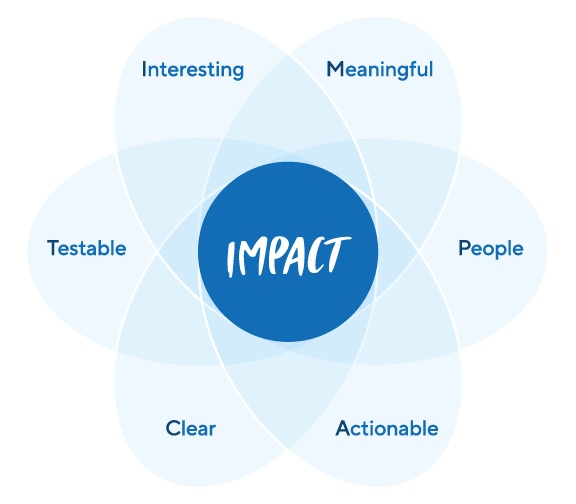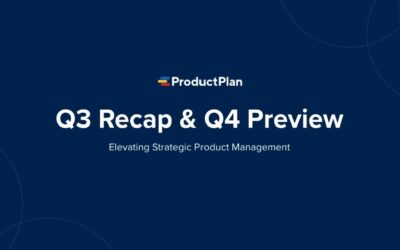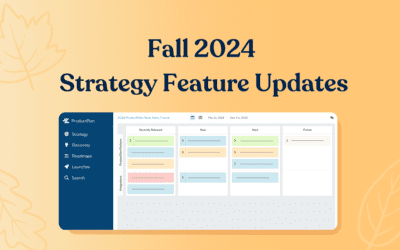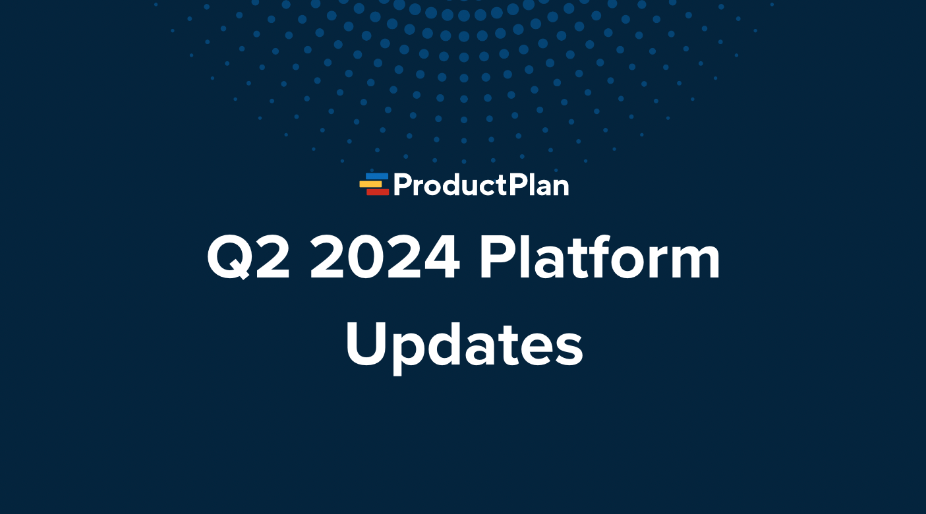After reading a blog or a book or attending a conference or talk on product management, I’m always excited to try out the new processes and frameworks I’ve learned about. I try to get my team similarly enthused about this endeavor. But when I check in with them in about a week, you can barely tell that anything had changed… mostly because it hadn’t.
We tend to fall back into how we were doing things before because that cool new process isn’t meaningful in itself. Without the context for why it’s the most important way to spend our time, it wasn’t worth investing in making a change.
So when I tried coming up with my own mindset and mantra for improving product management, I found myself elevating above the flowcharts and execution strategies, looking for something more universal. I wanted to tie together the entire ecosystem and to identify a unifying measuring stick. Something equally applicable to how we prioritize projects as it is to our own careers.
Most importantly, I wanted to invest our time in something that will stick and make us all more productive and efficient product teams. Thus came the genesis of IMPACT, where six words can create a lens to reexamine everything a product professional does to ensure it truly is creating an impact and maximizing the opportunity.
Meaningful Product Processes with IMPACT
Solving Interesting problems that are Meaningful to People, with Actionable plans that are Clear and Testable. That’s what IMPACT’s all about, and if we’re not infusing our processes with IMPACT, then we’re potentially spending our energy on the wrong things.
Interesting
By making the problem interesting, we start to build momentum. People need a reason to care, so it’s imperative we tell stories and use our storytelling skills in everything we do.
By helping our audience—from sales and marketing to engineering and QA—connect with the customer problem, we will drive better outcomes. We all know that when we focus on value over features, everyone’s happier.
The processes with IMPACT that help ensure we’re working on interesting problems include:
- Product discovery—Helps you better understand the customer problem and interestingly tell that story.
- Ideation & validation—Uncovers more meaning.
- Market research—Reveals how others tell their stories and perceive the audience.
- Customer feedback—A door into what’s happening and the trends and evolution in the market.
- Community involvement—Take any opportunity you can to be where your customers are and get more chances to hear their stories and the challenges they face.
- Event participation—Talk to people and learn about their lives outside your product for invaluable context.
Meaningful
Is your solution meaningful to the customer or the business? Remember that excitement about an idea doesn’t always translate to value. The real test is how much they’re willing to pay for it, which truly shows how much they value the solution.
Aside from generating revenue, it’s also important to check if the solution aligns with the business’s direction, vision, and values. These processes with IMPACT can help you articulate what’s meaningful to business:
- Vision & Mission—Although it’s often handed down from senior management, it still influences your work. You should be able to articulate how your solution aligns with the vision and mission. Then, prioritize things when necessary to create those connections.
- Strategy/Strategic Alignment—It should include a definition of value that the product is trying to deliver and what success looks like.
- Gracefully Saying No—If that really compelling idea doesn’t create meaning, communicate that to teams and customers ASAP, then move on.
- Roadmapping—Include components of the meaning and value you’re creating, as well as why it’s the right thing to do.
People
You must figure out the pervasiveness of the problem you’re solving and how many people will care. What will solving this problem unlock in the market?
Alongside understanding your research in solving the problem with a specific solution, it’s also essential to know how that investment may accelerate other innovations or solve related problems. This can lead to exponential growth and new opportunities beyond the original scope and scale of the situation.
By using as broad a lens as possible, you can also determine if you’re making a big impact for a small number of people or a small impact for a big number of people… both of which are worthy and sound investments, assuming there’s a willingness to pay. These processes can help quantify things:
- Competitive Analysis—Helps you understand which problems competitors are solving and how they frame them. Not to mention figuring out which ones they’re NOT solving.
- Market research—Helpful, but determine upfront how much you need to know to be confident to move forward to avoid analysis paralysis.
- Surveys—Determine who cares about this problem and how frequently it occurs.
- Jobs To Be Done/Opportunity Tree—Another tool to assess the problem’s pervasiveness and how big a deal it really is.
- Prioritization—Be sure you’re accounting for the people that will be impacted by value creation. Not catering to the whims of internal stakeholders or finicky edge cases.
- Segmentation—Use this to define your target market and zoom in on the people who will truly benefit and appreciate the value of your solution.
Actionable
Coming up with a great idea is pretty easy. Go ask a first grader, and they’ll give you some amazing, innovative ideas… that are completely unfeasible. Your job is to narrow things down to what’s possible, reasonable, and probable.
You need to know you can deliver the solution, regardless of how big or important the problem is. These processes can serve as a reality check on what’s truly doable:
- Squads/Team Composition—More effective teams, benefit the entire company. They must be constructed to get an optimal cross-section of talent and compatible personalities and work styles.
- Product Development processes—Find time to evaluate feasibility and LOE as early as possible to avoid wasting cycles un impractical pathways.
- Ideation/Validation—All ideas are welcome, but only those truly actionable given how the solution is framed should be pursued.
- Dependency Analysis—Larger teams, create more dependencies. Those dependencies increase the odds that the market will pass you by while you sort things out.
Clear
To build consensus, generate enthusiasm, and win over skeptics, you must be able to articulate the value statement of the solution clearly. This not only will help you secure resources and support for the project, but it also has a downstream impact on sales and marketing, as well as eventually how customers react to the value proposition.
Some key processes contribute to making sure the impact of the solution is clear to everyone:
- Roadmap/Road Show—You want to make sure it’s in front of audiences frequently enough that it’s current, accurate, and remains top of mind. This is especially key when there’s not yet a lot of trust in you or your ideas. It’s also crucial to ensure the roadmap presents the right amount of information for the specific audience. You don’t want to drown them in details or rush through the items they particularly care most about.
- Alignment—You want to be sure you’re all using the same language, OKRs, prioritization, etc., so you’re all happy with the result.
- Cross-Functional Collaboration—Evaluate how and when you interact with peers to be sure it’s frequent enough. These interactions should be in settings where they’ll feel heard and can have their concerns addressed.
- Documentation—People don’t read (except amazing blog posts like this!). Is it accomplishing what you need it to do? Does it match the TLDR summary you included at the top?
Testable
Humans aren’t very good at knowing what they need, just articulating what they THINK they need. Therefore you must validate that the planned solution is valuable as early as possible.
Embrace the sunk cost philosophy early and often. Additionally, don’t be afraid to walk away or initiate a significant course correction at any stage. This is only possible by leveraging processes that put your ideas to the test:
- Agile Product Development—Agile is about more than replacing waterfall; it’s how you can test, learn, and adjust. With Agile, you can forward efficiently while leaving room for learning moments and making corrections based on those findings.
- Beta Processes—It’s never too late to learn and change. Set expectations internally and with customers while capturing feedback during beta tests. This isn’t just a dress rehearsal but rather a chance to get real-world experience on what you think will work.
- Iterative Design—Boil things down to the smallest step you can take to deliver value. Then test, learn, and repeat.
- Usability Studies—You need tools to test and verify. So watching real customers try to use your product is one of the best options there is.
For more insights into how you can apply IMPACT to your processes, watch the webinar or download the free e-book today.






